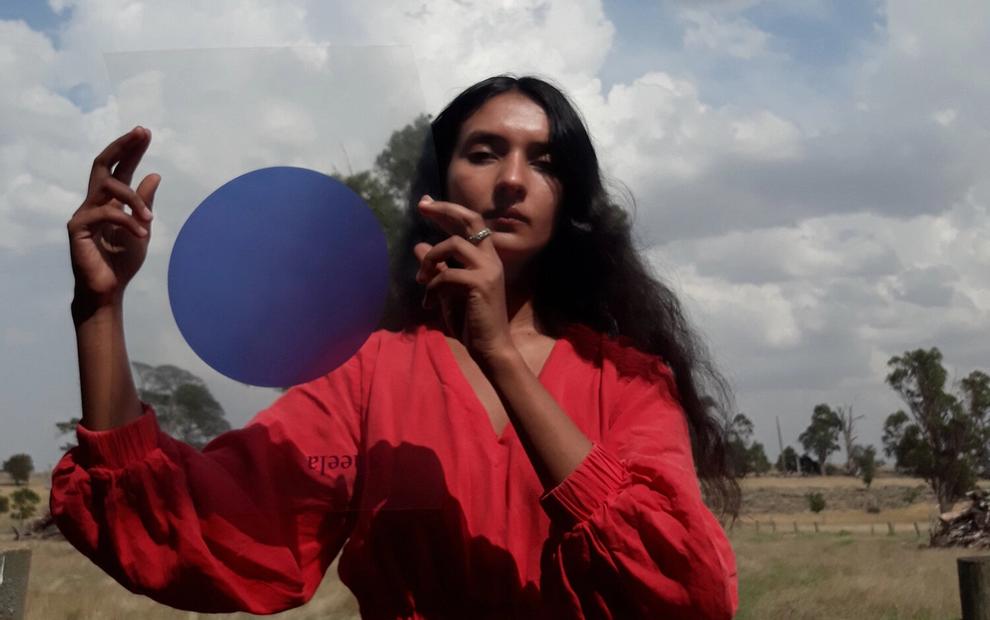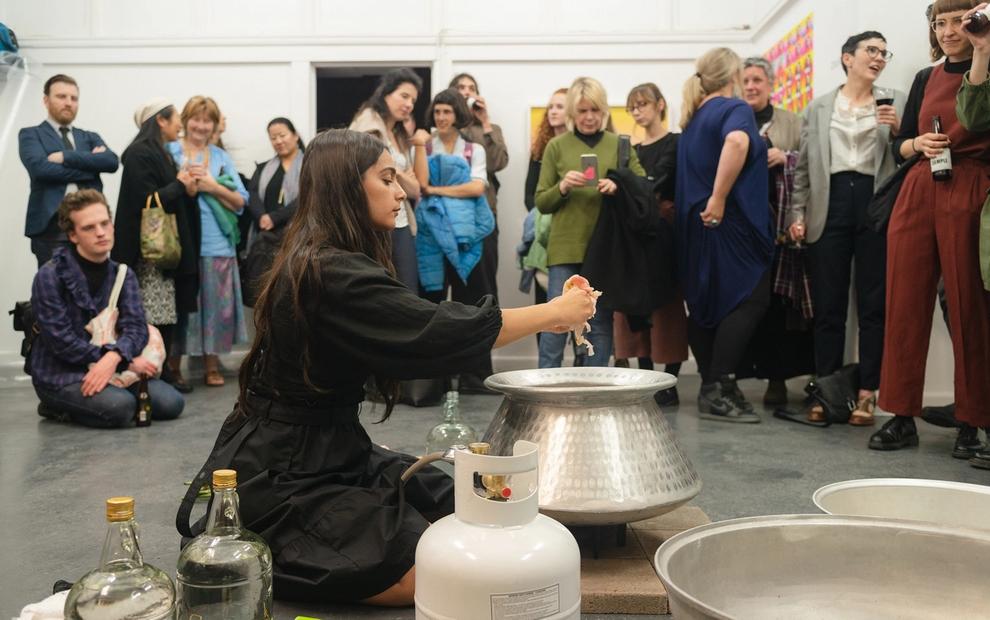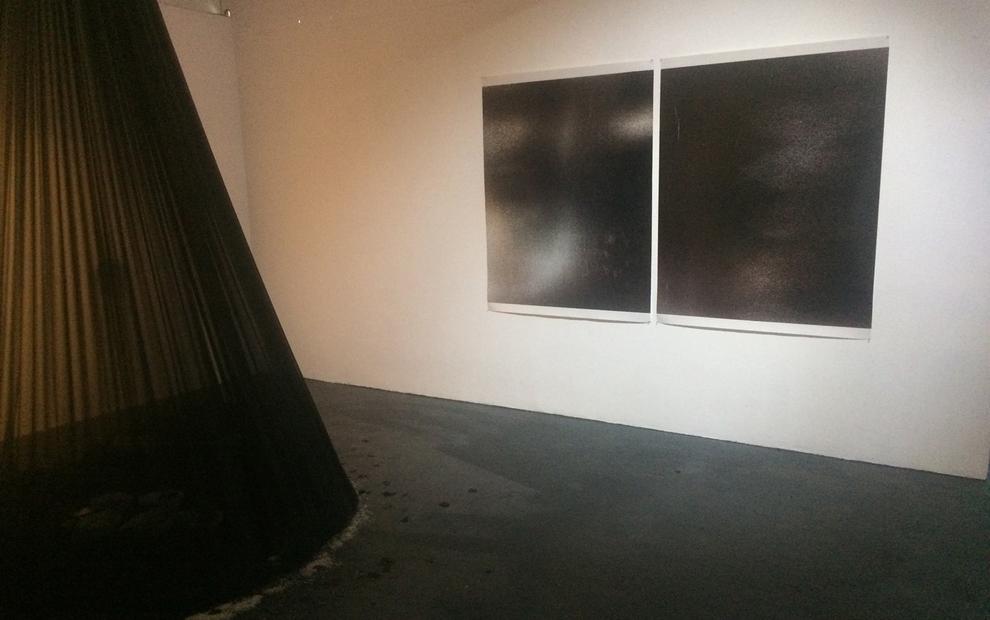Pearlescent Verse
Manisha Anjali, Hoda Ashfar, Tané Andrews, Walter Bakowski , Léuli Eshrāghi, Joe Joe Orangias, Nikki Lam, Blake Lawrence, Lucie McIntosh, Sean Miles, Angela Tiatia, Duha Ali + Justine Youssef
1 Mar–18 May 2019
This curated suite of videos explores the shared experiences surrounding water – how its flux of space brings us closer together, and at times may dislocate. Bodies of water become liquid fields of poetry and politics, surging rivers of connectivity, sharing founts of knowledge, and offering a wellspring of healing. In the work of twelve contemporary artists, water carries nourishment and transformation, bringing about unity and understanding through the fluid frameworks of identity, gender, culture, and memory.
The pearlescent verse speaks of social, ecological and spiritual narratives, and meditates upon the fragility of nature, human migration and the impacts of climate change. Screened across several public spaces in Australia, this exhibition promotes the richness of exchange and storytelling, respecting the Traditional Owners of the land and waterways.




















PLAY (2014-2019) was a continuously programmed online gallery that presented single channel video art by national and international artists to audiences throughout Australia and the world.
Pearlescent Verse is a screen-based exhibition presented through the channels of Satellite, a project broadcast through Blindside.
This program takes place on the land of the Wurundjeri people of the Kulin Nation. We recognise that sovereignty was never ceded - this land is stolen land. We pay respects to Wurundjeri Elders, past, present and emerging, to the Elders from other communities and to any other Aboriginal or Torres Strait Islanders who might encounter or participate in the program.
Manisha Anjali is a writer and artist based in Melbourne. She is the author of Electric Lotus, forthcoming from Incendium Radical Library Press, 2019. Manisha’s installations and performances have been exhibited at c3 contemporary art space, Bus Projects, SEVENTH Gallery, KINGS Ari, Melbourne Writers Festival, Queensland Poetry Festival, Emerging Writers Festival and National Young Writers Festival.
Hoda AshfarHoda Afshar (born 1983, Tehran. Lives and works Melbourne) explores the nature and possibilities of documentary image-making. Working across photography and moving-image, the Melbourne-based artist considers the representation of gender, marginality and displacement. In her artworks, Afshar employs processes that disrupt traditional image-making practices, play with the presentation of imagery, or merge aspects of conceptual, staged and documentary photography. Recent exhibitions include Khalas, UNSW Galleries, University of New South Wales, Sydney (2018); Waqt al tagheer: Time of Change, ACE Open, Adelaide (2018); and Behold, Centre for Contemporary Photography, Melbourne and Horsham Regional Art Gallery, VIC (2017/2018). In 2015, Afshar received the National Photographic Portrait Prize, National Portrait Gallery.
Tané Andrews (b. 1986) is an artist based in Sydney, Australia. His practice explores transience, transformations, and hybridizations within the natural world. Working with perishable organic materials including; flowers, living cocoons, wood, and water, as well as more durable products such as pearls, marble and bronze. Andrews’ artwork involve repetition, process, and a demand for meaningful contemplation. In 2007 he completed a Bachelor of Arts (Art) with First Class Honours at Curtin University, Perth. Andrews has exhibited nationally and internationally since 2011. Solo exhibitions include: Lying in Wait, Wellington St Projects Sydney (2016), The Collector, Venn Gallery Perth (2015) and Silent Distortions, Venn Gallery Perth (2014).
Walter Bakowski Walter Bakowski (b. 1996, Melbourne, Australia) is a graduate of the BA of photography at PSC, and is an emerging artist practising in performance art, documented through the photographic and moving image, the written word and installation. To date, Walter's work explores dialogues between art and spirituality, the sacred and the unseen - discovering the nuances of queer self in practice. Walter has been awarded as an exhibiting finalist in the Moran Contemporary Photography Prize and CLIP award. And has been part of numerous group shows at recognised contemporary art institutions including; Museum of Contemporary Art Australia, Centre for Contemporary Photography, Perth Centre for Photography and Seventh Gallery. Their work is held in private collections across Melbourne, Sydney, Paris and New York City, and in the public collection at the National Library of Australia. Walter’s recent body of work ‘Endure’, has recently been exhibited as part of a selection of group shows at institutions including Museum of Contemporary Art, Centre for Contemporary Photography and Seventh Gallery, creates discourse around the role of the spiritual ritual in facilitating the act of queering spaces.
Léuli Eshrāghi (he/ia) is an Australian artist, curator, writer from Sāmoan, Persian and other ancestries. Léuli completed a PhD in Curatorial Practice at Monash University in 2018 and is the inaugural Horizon Postdoctoral Fellow with the Initiative for Indigenous Futures at Concordia University in 2019. He holds qualifications in Indigenous arts management, francophone Great Ocean literature, Indigenous studies and comparative cultural studies. Léuli creates performances, installations, writing and curatorial projects centred on the body, ceremony, language renewal and hopeful futures. He exhibits and publishes regularly, and serves on the Aboriginal Curatorial Collective (Canada) board.
Joe Joe Orangias is a visual artist, activist and writer based between New York City and Geneva. His projects, often collaborative and site-specific, focus on social justice and environmental sustainability issues, and investigate the roles of cultural heritage. He earned a MFA from the School of the Museum of Fine Arts, Boston at Tufts University (SMFA), and a BFA from the Savannah College of Art and Design. Orangias has exhibited work at the Contemporary Arts Museum, Houston; the Cooper Hewitt-Smithsonian Design Museum, New York City; Gaffa Gallery, Sydney; Hinterconti Projects, Hamburg; Proof Gallery, Boston; and the Jockey Club Creative Arts Centre, Hong Kong; among other venues and public sites. He was awarded a SMFA Alumni Traveling Fellowship for research in Aotearoa New Zealand; an Art School Alliance Fellowship from the University of Fine Arts, Hamburg (HFBK) in Germany; and residencies at the Galveston Artist Residency, Art342 in Colorado, RM Gallery in Auckland and Atelier OPA in Tokyo. He has published writing in the Journal of Homosexuality and Scope: Contemporary Research Topics (Art: 11). He also makes projects as part of the collaborative Orangias+Eshraghi.
Nikki Lam’s practice explores the complexity of belonging through the exploration of self, memory and space. Working primarily with video, performance, text and installation, she is interested in exploring the translations of hybrid identities, often through studies of rituals, language and representations. Born in Hong Kong (1988), Nikki's work has been shown at Underbelly Arts Festival, SafARI, Firstdraft, BUS Projects, The Ferry Gallery (Bangkok, Thailand), Galleria Marcollini (Forli, Italy), and toured around the world with Over View International Festival of Video Art. Her most recent curatorial projects include Frames of Seeing (2017) at Nite Art, Flygirl by Caroline Garcia (2017), Screen as a Room (2016) at THE SUBSTATION and Channels Festival (2015).
Blake Lawrence was born and raised in Palmers Island, Northern NSW, across the lands of the Yaegl, Bundjalung, and Gumbaynggirr nations. He lives and works on the lands of the Gadigal people of the Eora nation, in Sydney. These lands were stolen and never ceded. He extends his deepest respect to their traditional custodians, and their elders: past, present, and emerging. Lawrence studied at the Sydney College of The Arts and has exhibited nationally at Firstdraft, Seventh Gallery, C3 Contemporary, The Walls, and Verge Gallery. He has presented performance work in Brisbane’s Spring Hill Reservoirs, Sydney’s Carriageworks, the Museum of Contemporary Art, and the Art Gallery of NSW.
Lucie McIntosh is an artist, curator and writer with a deep commitment to the independent arts community. She is currently a Director and Program Curator of Blindside, an independent, artist–run space based in the City of Melbourne. Lucie’s exhibition and research based practice explores process of signification and, more specifically, in how the process of signification might be made visible through the content of an artwork. Her practice emphasises the inherently plural and personal nature of meaning—reminding us of, and celebrating, our agency in its creation. Lucie is interested in the many ways that ‘the image’ can be expanded and consumed in political and philosophical contexts. Her practice relies on plurality and intertextuality—each artwork compulsively referencing its many varieties of self, content, history and maker.
Sean Miles is a cute Ngāti Raukawa takatāpui artist, respectfully doing mahi on sacred Woiwurrung (Wurundjeri) and Boon Wurrung land in Naarm/Melbourne. They maintain an interdisciplinary and process based practice that centres the correlations between trickster archetypes in ancient mythologies and contemporary queer performativity. They employ simplistic and immediate methods of transformation to shift environments and elevate at-hand objects into ritualistic materials and spaces for performance. They manifest visions that expose the horror of colonial and heteronormative social structures and concurrently fosters space for contemplation, healing and regeneration.
Angela Tiatia explores contemporary culture, drawing attention to its relationship to representation, gender, neo-colonialism and the commodification of the body and place, often through the lenses of history and popular culture. Tiatia's work has been included in a number of important institutional exhibitions, including After the Fall, National Museum of Singapore (2017/2018); Personal Structures, 57th Venice Biennial (2017); Eighth Asia Pacific Triennial of Contemporary Art (APT 8), Queensland Art Gallery | Gallery of Modern Art, Brisbane (2015/16); as well as Tūrangawaewae: Art and New Zealand, Toi Art, Gallery of the Museum of New Zealand Te Papa Tongarewa, Wellington, New Zealand (2018). She is represented by Sullivan + Strumpf in Sydney, Australia.
Duha Ali + Justine YoussefDuha Ali + Justine Youssef work across multiple disciplines through their collaborative practice, including video, installation, text and performance. Their practice is site-responsive and attentive to their respective origins in South-West Asia. The work is rooted in research into moments and places which allow them to move through questions surrounding post-colonial rhetoric, feminist lenses, and diasporic and material exchanges.
Jake Treacy is a curator, writer and poet whose practice employs numinous acts through exhibition-making, performativity, and the spoken and written word. They acknowledge that sovereignty was never ceded upon the Kulin Nations land from which they work, and pay their respects to Elders past, present and future across all First Nations. They are a University of Melbourne graduate with a Master of Art Curatorship (2017) and Postgraduate Art History (2013) who has previously co-directed an artist-run initiative, sat on grant advisory panels, and written published copy on numerous contemporary arts practices. Their recent thesis examines ways of constructing liminal experiences in order to incur healing, promoting inclusivity and community, and exercising the therapy of art. Their recent projects include Pearlescent Verse (Human Rights Arts and Film Festival), Apocalyptic Horse (Heide Museum), Utopian Tongues (Seventh Gallery), and Beyond the Veil (Blindside Gallery).
Related

3–22 Feb 2020
Mooramong Residency: Manisha Anjali
Manisha Anjali

18 Apr–5 May 2018
Intercambio Cuba Australia Video Exchange
Diana Fonseca Quiñones, Mia Salsjö, Adriana Arronte Rodríguez, Susana Pilar Delhante Matienzo, Robyne Latham, Naivy Peréz, Angela Tiatia

13–29 Sep 2018
All of Us
Teresa Hsieh, Liam Benson + Adorned, Jody Haines, Karen Casey, Mitch Mahoney + Molly Mahoney, Justine Youssef, Chloé Hazelwood

30 May–16 Jun 2018
Beyond the Veil
Anastasia Booth, Tess King, Josh Hook, Hernan Lopera, Daniel Gawronski, Cristal Johnson, Paulina Hupe, Guy Grabowsky, Diego Ramirez, Britt Salt, Michele Sierra, Jake Treacy, Jessica Alice










